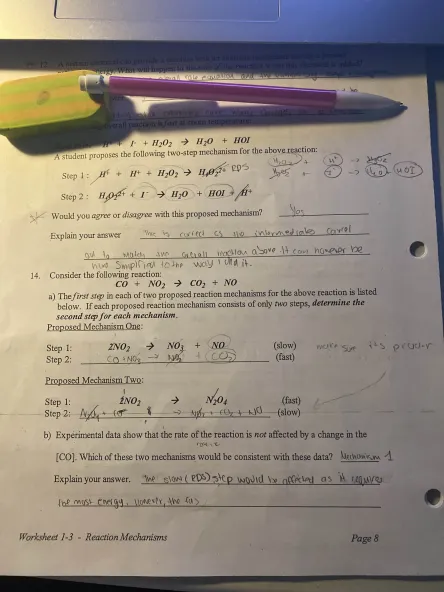Questions
1 a student proposes the following twostep mechanism for the

- A student proposes the following two-step mechanism for the above reaction:
Step 1: (fast)
Step 2: (slow)
Would you agree or disagree with this proposed mechanism?
Explain your answer:
- Consider the following reaction:
The first or second of two proposed reaction mechanisms for the above reaction is listed below. If each proposed reaction mechanism consists of only two steps, determine the second step for each mechanism:
Proposed Mechanism One:
Step 1: (slow)
Step 2: ________________________
Proposed Mechanism Two:
Step 1: (fast)
Step 2: _______________________
b) Experimental data show that the rate of the reaction is not affected by a change in the . Which of these two mechanisms would be consistent with these data?
Explain your answer:
Answers :
Question 1:
Would you agree or disagree with this proposed mechanism?
Answer: Agree.
Explanation:
The proposed mechanism is consistent with the overall reaction, and it includes a plausible rate-determining step. In Step 1, reacts with to form and . Then, in Step 2, reacts with another to produce and . The slow step (Step 2) determines the rate of the reaction, which aligns with the mechanism's proposal.
Question 2:
a) Determine the second step for each mechanism:
Proposed Mechanism One:
Step 2:
Explanation:
In the first mechanism, the intermediate formed in the slow step reacts with to complete the reaction and produce .
Proposed Mechanism Two:
Step 2:
Explanation:
In the second mechanism, the first step is fast and produces and directly. Therefore, the second step must regenerate any intermediates or complete the reaction, involving .
b) Which of these two mechanisms would be consistent with the experimental data?
Answer: Mechanism 1.
Explanation:
The experimental data show that the rate of the reaction is not affected by a change in . In Mechanism 1, the slow step involves only , so the reaction rate depends only on the concentration of , which aligns with the data. In contrast, Mechanism 2 suggests the rate depends on , which contradicts the experimental data.
Answered By

